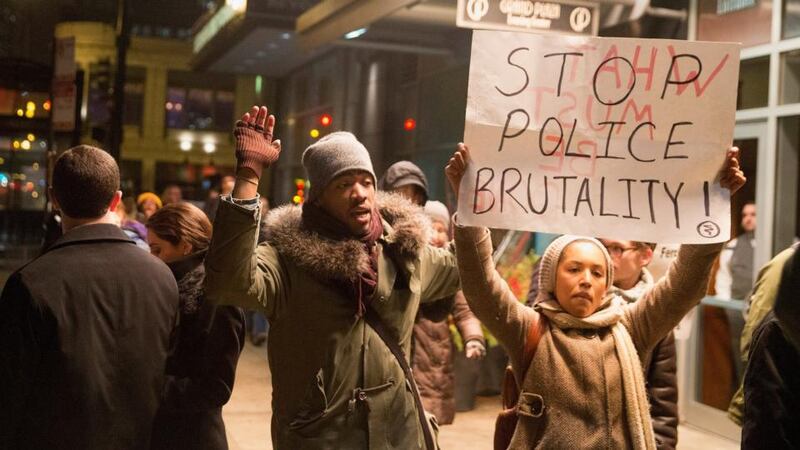Protesters in New York and other cities rallied for a third night on Friday denouncing the use of deadly force by police against minorities.
The protests came even as prosecutors said they would consider charges against an officer in the fatal shooting of a unarmed black man in November.
The killing of Akai Gurley (28), shot dead in a dimly lit stairwell in Brooklyn, was the latest in a string of lethal police actions feeding US public outrage over what many perceive as racially based violence by law enforcement.


This week's wave of angry but largely peaceful protests began on Wednesday when a New York grand jury declined to bring charges against white officer Daniel Pantaleo in the chokehold death of Eric Garner, a black 43-year-old father of six.
Mr Garner, who had no weapon, was being arrested on suspicion of selling cigarettes illegally. A videotape of his confrontation with police on Staten Island in July showed Mr Pantaleo’s arm across Mr Garner’s neck as he is subdued by four officers, then Mr Garner was pinned face down to the pavement as he repeatedly gasps, “I can’t breathe” - a phrase protesters have adopted as a rallying cry.
The decision sparing Mr Pantaleo from prosecution was announced nine days after a Missouri grand jury chose not to indict a white policeman for the shooting death in August of an unarmed black teenager in the St Louis suburb of Ferguson, spurring two nights of arson and unrest there.
Then on Thursday in Phoenix, Arizona, another unarmed black man was shot dead by a white police officer during a scuffle, leading to protests.
“The government has created a monster and the monster is now loose,” said Soraya Soi Free (45), a nurse from the Bronx who has been protesting in New York.
After two nights that saw thousands of demonstrators pouring into the streets and blocking traffic in Manhattan, the turnout on Friday saw only hundreds as a cold, steady rain fell.
But in a surprising departure from previous nights, more than 100 people stormed into an Apple Store to stage a brief “die-in”, sprawling on the floor as shoppers and employees watched. They left without incident after about five minutes.
Similar demonstrations were staged at Macy’s flagship department store in Herald Square and at Grand Central Terminal, one of the city’s two main rail stations. As they did at the Apple store, police stood by but allowed the protesters to briefly occupy both locations.
Some Manhattan retailers have curtailed their hours in response to the recent unrest, including Best Buy Co Inc and Target Corp.
Meanwhile, nearly 100 people, including local civic leaders, huddled under umbrellas near the site of Garner’s death for a candlelight vigil on Staten Island.
“This is a movement, a rainbow of people,” the Rev Demetrius Carolina of the First Central Baptist Church told the racially mixed crowd.
A dwindling group of marchers who pressed on through the rain were confronted by police on Manhattan’s lower East Side before midnight. Police arrested several protesters.
Among them were Chloe Dewberry (22), who had shrugged off the chilling downpour. “No one ever got anywhere by giving up when it got tough,” she said. “I’m so enraged, I don’t even notice.”
Protests also unfolded in Chicago, Boston and Washington, DC, where marchers echoed demonstrators across the country, chanting “Black lives matter,” and “I can’t breathe.”
Renee Alexander (44), a nurse from Woodbridge, Virginia, who joined about 200 protesters in downtown Washington, expressed outrage over the video images of Mr Garner's death. "It's heartbreaking for me to watch, over and over on TV, how his life was cut short on the street, just like a dog," she said. "They had no respect for him. No human being should die in the street like that - choked to death."
Brooklyn District Attorney Kenneth Thompson said on Friday he will convene a grand jury to consider charges against the New York City officer who shot Mr Gurley. Police there have said the officer, Peter Liang, may have accidentally discharged his gun.
In Cleveland on Friday, the family of a 12-year-old boy fatally shot by police filed a lawsuit against the city, a day after the federal government found the police department systematically uses excessive force.
Elsewhere in the Midwest, activists on Friday concluded a 190km protest march to the Missouri governor's mansion from Ferguson, where 18-year-old Michael Brown was shot to death in August by a policeman who initially stopped the teenager for walking in the street.
Some witnesses to the confrontation told a grand jury that Mr Brown had raised his hands in the air before he was killed, though others contradicted that testimony.
Reuters











